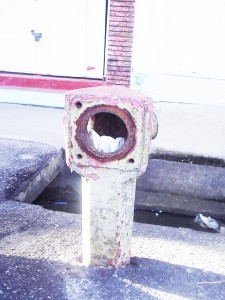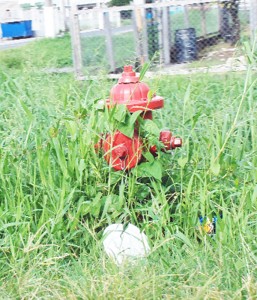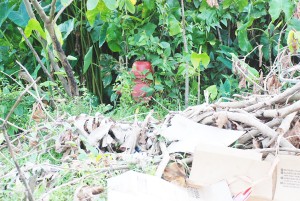-many not working
After years of uncertainty and squabbling as to which entity is responsible for fire hydrants this issue is still to be resolved.

A drive around the city reveals the state of the hydrants, with many having been vandalized including in the downtown business areas. Although the capacity of the fire service has been boosted with the acquisition of new equipment, the issue of the hydrants remains a sore one. Chairperson of the Fire Advisory Board, Clinton Urling said that he would “suspect that most are not functioning”.
Questioned about the Guyana Fire Services (GFS’s) role with regards to the hydrants, Deputy Chief Fire Officer, Marlon Gentle told Stabroek News that the service had no responsibility for the hydrants though they would inspect and test them for serviceability. He said that reports on the defects are then forwarded to the Guyana Water Inc (GWI). “We are not responsible for fire hydrants”, he declared stating that this was the responsibility of the water utility. With regards to installation, he said that this is not the role of the GFS and it does not have the capability to do so. He underscored that hydrants were important in firefighting but noted that at present water is mostly garnered from open sources. He said that factors that would see hydrants not being utilized include vandalism, low water pressure or the total absence of hydrants.

However, a representative of the water utility had earlier pointed out that there is nothing in the law that points to the company being responsible for the hydrants.
Urling however, told this newspaper that in the absence of the necessary legislation, the obligation to manage the hydrants rests with GWI, though this responsibility is ambiguous. He pointed to the fact that in many countries, this duty fell to the water utilities.
The City Council was also said to be responsible for the hydrants within the city but when contacted Georgetown Mayor Hamilton Green said this is not so.
Following several devastating fires in 2003-2004, that left hundreds of millions of dollars in losses, questions were raised about who has the responsibility for the hydrants, given that many were non-functional. At that time both the fire service and the water service had pointed fingers and denied that they were responsible. In the wake of this, a committee was to be set up to examine the management of the fire hydrants.

“It is lamentable that, out of a total of about 580 fire hydrants located in the city of Georgetown, fewer than 90 are functional,” the commission had noted in the report calling it an unsatisfactory state of affairs that needed to be resolved. This newspaper was unable to determine the number of working fire hydrants at present but observers say that the number of those not functioning is significant.
From reports of recent fires, in cases where hydrants are nearby, they seemed not to have played a major role, if any at all. When the Hamson’s General Store on Regent Street was destroyed by fire in April, the firemen had to source water from the North Road and South Road canals, which are a couple of streets away. This allowed the fire to grow, as after the tenders ran out of water, precious time was lost looking for other sources. When the fire service had arrived at that fire, only smoke was seen and in the time that it took to source the water, the fire had grown. The store was destroyed though the firemen managed to save neighbouring buildings.
But similar problems had cropped up before. Back in November 2003, when a fire caused by a falling utility pole destroyed Royal Castle, Mohamed’s Enterprise and Auto Supplies Co, none of the hydrants in the Lombard Street area had been working and the GFS had to source water from the Demerara River.
So the question remains as to who bears responsibility for the hydrants. Urling told Stabroek News that none of the Acts governing the GFS and GWI specifically addresses this issue.
But will this be changed anytime soon? Urling said that the Water Resources Sub-Committee of the board is tasked with dealing with this but the issue was placed on the back-burner due to consultations that were taking place between the two utilities. Asked about this, Gentle said that he is unaware of any such consultations.
Urling had noted that one of the issues being worked on was reforming the legislation and the board was working on draft legislative reforms to present to the ministry.
As of now, there is only a small reference to hydrants in the Fire Service Act. Section 12 (2) (d) of the Fire Service Act states that at the close of the financial year, or as often as is required by the Minister of Home Affairs, the Chief Fire Officer is to report to the minister in writing the condition of the stations, hydrants, hoses, vehicles, fire-boats, fire-engines, and all other fire equipment and property under his charge.
The Water and Sewerage Act does not mention anything of hydrants.
Boom
Meantime, Urling expressed concern that with a boom in construction, the necessary infrastructure such as hydrants is not in place. He noted that laying pipes and supplying water was the mandate of GWI and the GFS could not simply decide to do that. “The issues that deal with water flow to the hydrants has to do with the water service”, he asserted pointing out that in other countries such as Barbados, the country’s water utility oversees the hydrants.
He noted that there has to be collaboration between the Ministry of Home Affairs and the Ministry of Housing and Water and in the absence of the appropriate and necessary legislation the responsibility lies with the two utilities, with one the supplier and the other the user. As regards the work of the board, Urling said that the water utility had no representative on the board and one has been requested. He stated that any discussion had to include GWI.
Urling noted that a number of recommendations were made and the minister was aware of these things. He added that there was nothing preventing the government from addressing the issue and assigning responsibility.
Meantime, Green, in stating that the municipality has no responsibility for the fire hydrants, said that in times gone by, the city had only a peripheral and informal role in relation to maintenance. He said that though he raised the matter several times, nothing was done. The mayor stated that the government should take up the matter with the Attorney-General to legislate who should be held responsible. He noted that whenever there is a fire the issue comes up.

